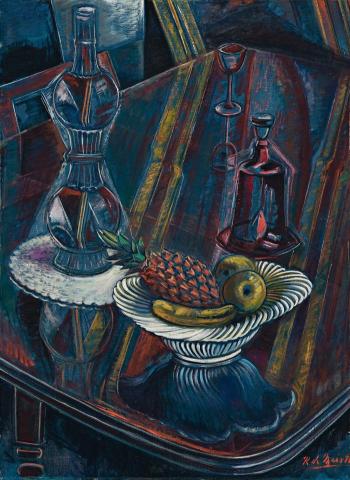STILL LIFE WITH BOTTLE AND FRUIT
Roy De Maistre
oil on canvas
96.5 x 71.0 cm
signed lower right: R de Maistre
label verso with title ‘Still Life with Lamp’
Estate of the artist, London
Thence by descent
Private collection, Melbourne
Roy de Maistre's gifted sense of colour came to the fore in his early work in Sydney, especially through his interest in the relationship between colour and music. He also experimented with abstraction, as in the colourful Rhythmic Composition in Yellow Green Minor, 1919, in the collection of the Art Gallery of New South Wales. Eventually settling in England, de Maistre concentrated on painting still life and religious subjects, together with interiors, figure compositions, and the occasional portrait. Drawing on both figuration and abstraction, his paintings inclined towards a form of Cubism in which representation underwent a geometrical transformation. Sufficient realism remained for ready identification, while the eye can delight in the new manner in which the forms are realised. This is delightfully so with Still Life with Bottle and Fruit. Here, as in so much of his mature work, the main dialogue is between the illusion of form and flatness. Ian McLean, writing about a related 1946 painting, Studio Still Life with Lamp, described it thus: 'The latter work is a studio interior in which de Maistre has employed a flattened cubist space but left the objects as solid forms rather than as ones penetrated by spatial planes.' He added, 'de Maistre's depiction of the relationship between objects and space in this work stems more directly from Cézanne than from Picasso and Braque.'1
In our painting, the foreground objects of bowl of fruit and bottle are striking in their illusion of the three dimensional, contrasting with the flatness of their reflections in the tabletop. This is developed further in the other objects and their reflections, especially of the armchair, its reflection counteracting any illusion of depth suggested by perspective. Diagonals are balanced by verticals and curves, causing the eye to ascend the picture plane, and giving the painting something of that fascination of looking into a mirror. The interest in this painting lies very much in the play between the illusion of the reality of the created image and its flattened reflection, housed within a shallow pictorial space. The subtle colouring and tonal relationships add a further note to that of imaginative enquiry in which the artist's exploration of the individual object is kept in felicitous harmony with the whole. A lively sense of rhythm pervades forms and colours in a happy celebration of the individuality of his art.
1. McClean, I., 'Two Modern Artists', Art Notes, London, Summer 1946, quoted in Johnson, H., Roy de Maistre, The English Years, 1930-1968, Craftsman House, Sydney, 1995, p. 138
DAVID THOMAS
